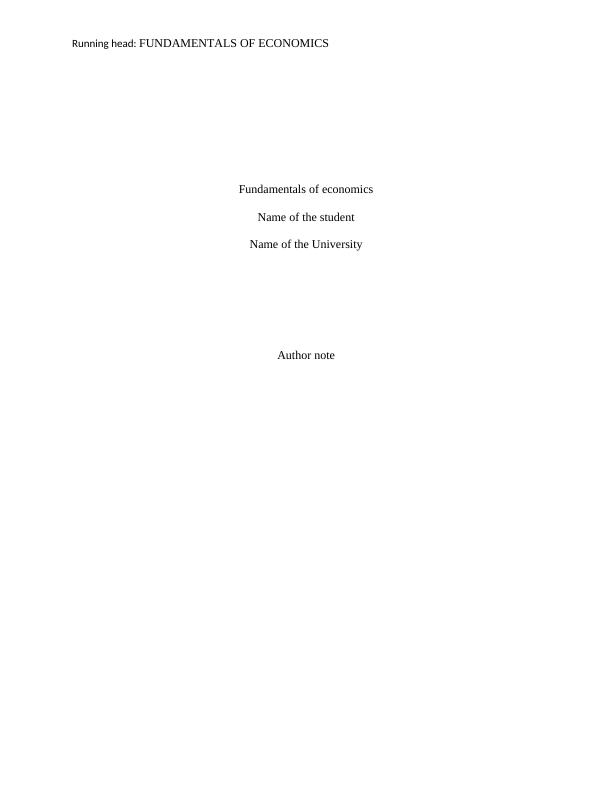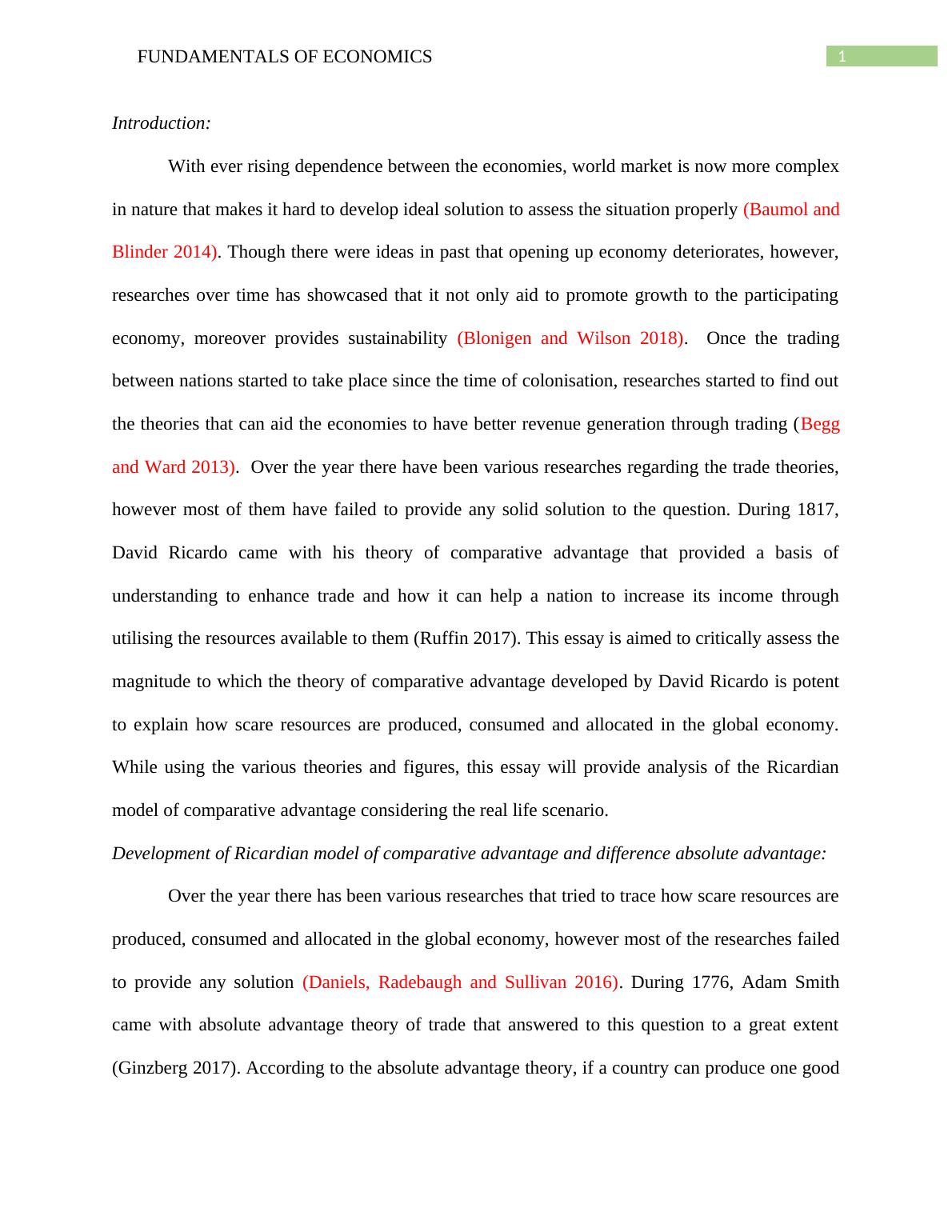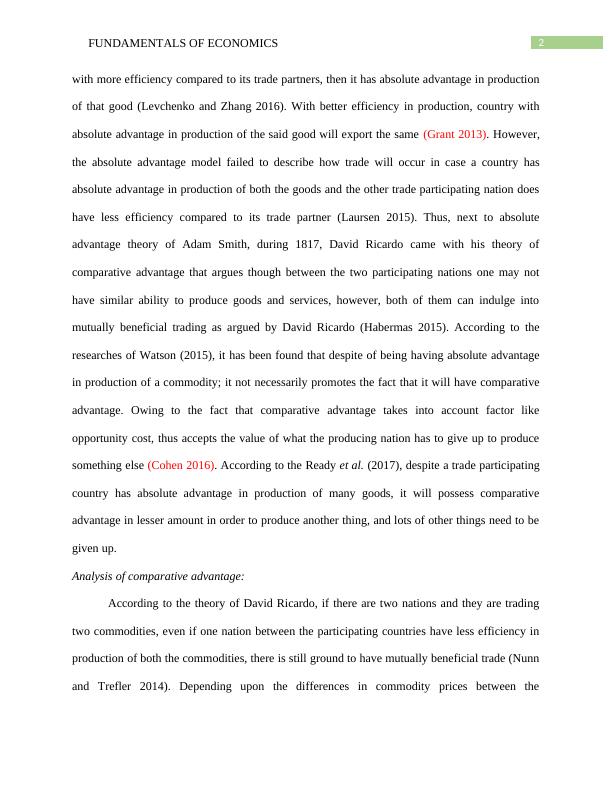Fundamentals of Economics- Essay
Added on 2021-04-21
13 Pages3376 Words31 Views
Running head: FUNDAMENTALS OF ECONOMICSFundamentals of economicsName of the studentName of the UniversityAuthor note

1FUNDAMENTALS OF ECONOMICSIntroduction:With ever rising dependence between the economies, world market is now more complexin nature that makes it hard to develop ideal solution to assess the situation properly (Baumol andBlinder 2014). Though there were ideas in past that opening up economy deteriorates, however,researches over time has showcased that it not only aid to promote growth to the participatingeconomy, moreover provides sustainability (Blonigen and Wilson 2018). Once the tradingbetween nations started to take place since the time of colonisation, researches started to find outthe theories that can aid the economies to have better revenue generation through trading (Beggand Ward 2013). Over the year there have been various researches regarding the trade theories,however most of them have failed to provide any solid solution to the question. During 1817,David Ricardo came with his theory of comparative advantage that provided a basis ofunderstanding to enhance trade and how it can help a nation to increase its income throughutilising the resources available to them (Ruffin 2017). This essay is aimed to critically assess themagnitude to which the theory of comparative advantage developed by David Ricardo is potentto explain how scare resources are produced, consumed and allocated in the global economy.While using the various theories and figures, this essay will provide analysis of the Ricardianmodel of comparative advantage considering the real life scenario.Development of Ricardian model of comparative advantage and difference absolute advantage: Over the year there has been various researches that tried to trace how scare resources areproduced, consumed and allocated in the global economy, however most of the researches failedto provide any solution (Daniels, Radebaugh and Sullivan 2016). During 1776, Adam Smithcame with absolute advantage theory of trade that answered to this question to a great extent(Ginzberg 2017). According to the absolute advantage theory, if a country can produce one good

2FUNDAMENTALS OF ECONOMICSwith more efficiency compared to its trade partners, then it has absolute advantage in productionof that good (Levchenko and Zhang 2016). With better efficiency in production, country withabsolute advantage in production of the said good will export the same (Grant 2013). However,the absolute advantage model failed to describe how trade will occur in case a country hasabsolute advantage in production of both the goods and the other trade participating nation doeshave less efficiency compared to its trade partner (Laursen 2015). Thus, next to absoluteadvantage theory of Adam Smith, during 1817, David Ricardo came with his theory ofcomparative advantage that argues though between the two participating nations one may nothave similar ability to produce goods and services, however, both of them can indulge intomutually beneficial trading as argued by David Ricardo (Habermas 2015). According to theresearches of Watson (2015), it has been found that despite of being having absolute advantagein production of a commodity; it not necessarily promotes the fact that it will have comparativeadvantage. Owing to the fact that comparative advantage takes into account factor likeopportunity cost, thus accepts the value of what the producing nation has to give up to producesomething else (Cohen 2016). According to the Ready et al. (2017), despite a trade participatingcountry has absolute advantage in production of many goods, it will possess comparativeadvantage in lesser amount in order to produce another thing, and lots of other things need to begiven up. Analysis of comparative advantage:According to the theory of David Ricardo, if there are two nations and they are tradingtwo commodities, even if one nation between the participating countries have less efficiency inproduction of both the commodities, there is still ground to have mutually beneficial trade (Nunnand Trefler 2014). Depending upon the differences in commodity prices between the

3FUNDAMENTALS OF ECONOMICSparticipating nations, Ricardian model of comparative advantage has been developed. Theory ofcomparative advantage argues that the trade participating nation that has lower relative price inproduction of a good has comparative advantage in production of the said good (Perman andScouller 1999). Similarly good that has high relative price of production has comparativedisadvantage in production (Fridell and Ervine 2015). In practical terms, theory of thecomparative advantage provides the idea that between the two trade participating nations, onewill export that commodity in which it has comparative advantage and the same country willimport in which it has comparative disadvantage. Next to this, during 1919 another idea thatdescribe how scare resources are produced, consumed and allocated in the global economy cameinto existence known as the Heckscher – Ohlin model (Feenstra 2015). Heckscher- Ohlin model of comparative advantage:Heckscher – Ohlin Factor Endowment model is the extended version of the comparativeadvantage theory, that assess the comparative advantage through stating that differentcommodity requires different factor proportion to get produced and different economies havedifferent amount of these factor endowment capability. Thus, trade participating countries willproduce and export those goods only that utilise the resources, which are endowed to them(Tietenberg and Lewis 2016). Depending upon the factor abundance theory a nation will importonly that commodity in which production requires those factors of production which are scares inthe nations and expensive to avail. Thus, Heckscher – Ohlin model argues nations, export importcapability will not only consider the opportunity cost to determine the trade flow, besides this, itis important to consider the factor endowment intensity (Grossman, Helpman and Kircher 2017).Considering this, trading country that has abundance in capital will produce and export capitalintensive goods and it will import labour intensive goods and services. On the other hand, those

End of preview
Want to access all the pages? Upload your documents or become a member.
Related Documents
Fundamental of Economics - Essaylg...
|13
|3219
|49
Assignment on Economic in UKlg...
|15
|2255
|45
International Economics: Absolute and Comparative Advantage, NAFTA, Singapore's Economic Strategies, Balance of Payment and Currency Strengthlg...
|11
|1799
|349
Principles of Political Economy and Taxationlg...
|8
|1922
|12
(PDF) Fundamental of Economicslg...
|13
|3045
|348
Fundamentals of Economics PDFlg...
|11
|2464
|33
